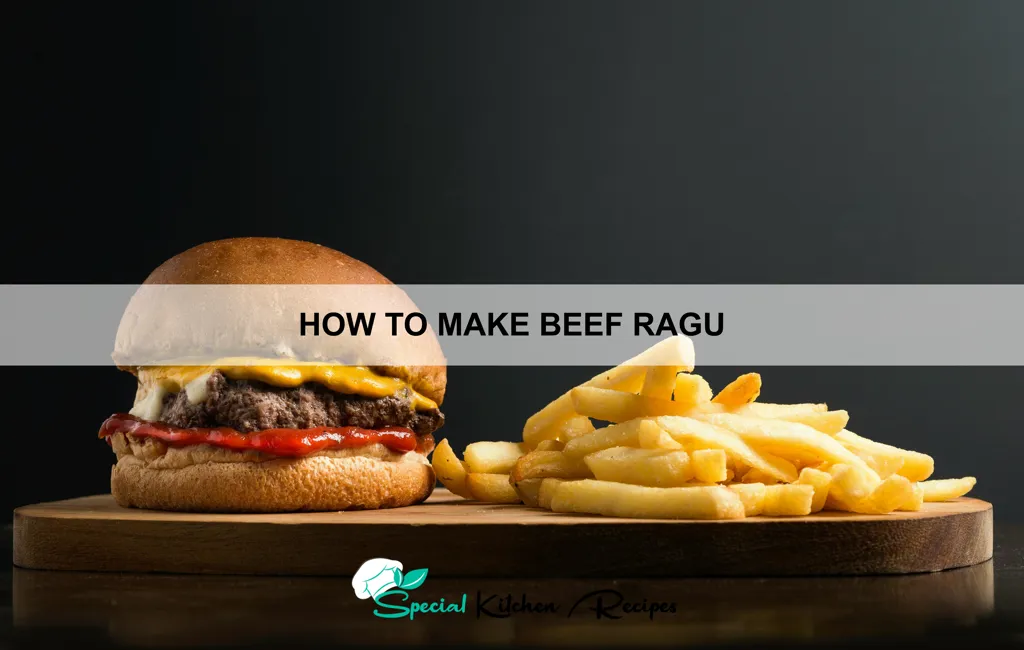Beef ragu, a culinary cornerstone of Italian cuisine, boasts a history as rich and complex as its flavor profile. While pinpointing its exact origins is difficult, the dish’s evolution is intrinsically linked to the development of tomato cultivation in Italy. Before the widespread adoption of tomatoes in the 16th century, ragùs were primarily based on meat stews, often featuring wild game or pork. The arrival of tomatoes from the Americas revolutionized Italian cooking, and by the 18th and 19th centuries, tomato-based ragùs, particularly those featuring beef, had become prevalent throughout the country, especially in Emilia-Romagna and Bologna, the regions often considered its heartland.
The cultural significance of beef ragu is profound. It’s far more than just a dish; it’s a symbol of family, tradition, and comforting home-style cooking. Many Italian families possess secret recipes passed down through generations, each subtly different, reflecting regional variations and personal preferences. The long, slow cooking process itself is symbolic – a dedication of time and effort mirroring the importance of family and shared meals. Think of Sunday dinners, where the aroma of simmering ragu fills the home, creating a sense of warmth and togetherness. This sentiment is so deeply ingrained that statistics show a significant increase in ragu consumption during holidays and family gatherings across Italy.
Interestingly, the term ragù itself is somewhat debated. While widely used in Italy, it’s not a universally understood term. In the United States, ragù is often used interchangeably with Bolognese sauce, though purists argue they are distinct. Bolognese sauce, often characterized by its finely minced ingredients, is considered a specific type of ragù, originating from Bologna. In contrast, a broader definition of ragù encompasses a wider variety of meat-based sauces, often featuring larger chunks of meat and a greater diversity of vegetables. This culinary nuance underscores the rich tapestry of Italian regional cooking and the ongoing evolution of this beloved dish. Regardless of its precise name, the enduring popularity of beef ragu is a testament to its deliciousness and its powerful connection to Italian culture and heritage.
Ingredients and Measurements
Creating a truly exceptional Beef Ragu hinges on the quality and precise measurement of your ingredients. Don’t skimp on quality – a good cut of beef will yield a richer, more flavorful sauce. This recipe uses 1.5 lbs (approximately 680g) of beef chuck, cut into 1-inch cubes. Chuck is ideal because it’s relatively inexpensive, yet boasts enough marbling to render beautifully during the long simmering process. You can substitute with other tough cuts like beef stew meat, but adjust cooking time accordingly.
Next, we need the aromatics. We’ll use 1 large onion, finely chopped. The finer the chop, the better it will integrate into the sauce. Avoid pulsing it in a food processor, as you want some texture to remain. Along with the onion, we’ll use 2 carrots, peeled and finely diced, and 2 celery stalks, also finely diced. This classic mirepoix forms the base of many rich sauces.
For depth of flavor, we’ll incorporate 3 cloves of garlic, minced. Don’t over-mince the garlic; you want small pieces but not a paste. Too much garlic can overpower the delicate beef flavor. We’ll also use 1 (28 ounce) can of crushed tomatoes. Look for San Marzano tomatoes for the best flavor, but any good quality crushed tomatoes will work. A 15-ounce can of tomato paste adds further richness and body to the sauce.
Now for the seasonings: 1 teaspoon of dried oregano, ½ teaspoon of dried basil, ¼ teaspoon of red pepper flakes (optional, adjust to your spice preference), 1 teaspoon of salt, and ½ teaspoon of black pepper. Seasoning is crucial; taste and adjust as you go. Start with these measurements and add more salt or pepper as needed towards the end of cooking. A splash of red wine (about ½ cup) adds complexity and depth. Dry red wine like Cabernet Sauvignon or Merlot works well. If you prefer to omit the alcohol, substitute with an equal amount of beef broth.
Finally, we’ll need 2 cups of beef broth to help maintain the moisture level during the long simmer. Always use good quality broth; it significantly contributes to the overall flavor. And don’t forget a generous tablespoon of olive oil for sautéing the meat and vegetables.
Remember to have all your ingredients prepped and measured before you begin cooking. This will ensure a smooth and efficient cooking process, allowing you to focus on developing the rich flavors of your Beef Ragu.
Preparation of Ingredients
Before you begin assembling your Beef Ragu, meticulous preparation of the ingredients is key to achieving a rich and flavorful sauce. This stage sets the foundation for the entire dish, so take your time and pay attention to detail.
Start by preparing your vegetables. We’ll need one large onion (about 250g), two carrots (approximately 150g), and two celery stalks (about 100g). Finely chop the onion. Aim for a consistent dice, about 1/4 inch in size. This ensures even cooking and prevents large pieces from overpowering the delicate flavors of the ragu. Roughly chop the carrots and celery into similarly sized pieces, about 1/2 inch. Don’t worry about being overly precise here; a rustic chop adds to the charm of the ragu.
Next, prepare your beef. We’ll use 1 lb (450g) of ground beef, preferably a blend of 80/20 lean to fat for optimal flavor and moisture. If using chuck or other tougher cuts, you’ll need to coarsely chop them before browning. For this recipe, ground beef provides ease and even cooking. Avoid overcrowding the pan when browning the meat; this will result in steaming instead of browning, leading to a less flavorful ragu. Work in batches if necessary, ensuring each batch is well browned before adding the next.
Browning the beef is crucial. Heat 2 tablespoons of olive oil in a large, heavy-bottomed pot or Dutch oven over medium-high heat. Add the ground beef and cook, breaking it up with a spoon, until it’s browned throughout. Drain off any excess fat. This step adds depth of flavor and prevents the ragu from being greasy. The browning process also helps to develop the Maillard reaction, contributing significantly to the overall taste.
Tip: For a deeper, richer flavor, you can add a pinch of salt and freshly cracked black pepper to the beef while browning. This seasons the meat from the inside out.
Once the beef is browned and the vegetables are prepped, you’re ready to move on to the next stage of the recipe. Remember, proper preparation is the foundation of a delicious Beef Ragu.
Cooking the Beef (Searing, Simmering, Reducing Sauce)
Begin by preparing your beef. For a rich and flavorful ragu, we’ll use approximately 1.5 lbs of beef chuck, cut into 1-inch cubes. This cut is ideal due to its high fat content and connective tissue, which will break down during the long simmering process, resulting in a tender and succulent ragu.
Searing the beef is crucial for developing deep, complex flavors. Season the beef cubes generously with salt and freshly ground black pepper. Heat 2 tablespoons of olive oil in a large, heavy-bottomed pot or Dutch oven over medium-high heat. Work in batches to avoid overcrowding the pot, ensuring a good sear on all sides. This should take about 5-7 minutes per batch. Once seared, remove the beef from the pot and set aside.
Next, we’ll build the flavor base of our ragu. Add 1 large diced onion, 2 carrots, finely diced, and 2 celery stalks, also finely diced, to the pot. Sauté these vegetables in the rendered beef fat until softened, about 5-7 minutes. This process, known as the soffritto, is fundamental to many Italian sauces. Don’t be afraid to let the vegetables brown slightly; this adds depth of flavor.
Return the seared beef to the pot. Add 1 (28 ounce) can of crushed tomatoes, 1 cup of dry red wine (such as Chianti or Cabernet Sauvignon), 2 cups of beef broth, 2 tablespoons of tomato paste, and 1 teaspoon of dried oregano. Stir well to combine all ingredients. Bring the mixture to a simmer, then reduce the heat to low, cover the pot, and let it simmer gently for at least 2-3 hours, or up to 4 hours for an even richer flavor. The longer it simmers, the more tender the beef will become.
After simmering, it’s time to reduce the sauce. Remove the lid and increase the heat to medium-low. Simmer uncovered for another 30-45 minutes, allowing the sauce to thicken and the flavors to intensify. Stir occasionally to prevent sticking. Taste and adjust seasoning as needed, adding more salt, pepper, or a pinch of sugar to balance the acidity if necessary. The goal is a rich, deeply flavored sauce that clings beautifully to the pasta.
Once the sauce has reached your desired consistency, your Beef Ragu is ready. Serve it over your favorite pasta, such as pappardelle or tagliatelle, and garnish with freshly grated Parmesan cheese and a drizzle of olive oil.
Adding Vegetables and Aromatics
The foundation of a truly great beef ragu lies in the careful preparation and cooking of its vegetables and aromatics. This stage builds the depth of flavor that will permeate the entire dish. We’ll be using a classic combination, but feel free to adapt it to your preferences. Remember to use good quality ingredients; the better the ingredients, the better the ragu.
Begin by finely chopping 1 large onion (approximately 1 cup chopped). Use a sharp knife for a consistent chop, ensuring even cooking. Next, finely chop 2 carrots (about 1 cup chopped) and 2 celery stalks (about 1 cup chopped). These form the classic mirepoix, the aromatic base of many sauces. The fine chop is crucial here; it ensures the vegetables soften and meld into the sauce without leaving large, unpleasant pieces.
In a large, heavy-bottomed pot or Dutch oven (at least 6-quart capacity), heat 2 tablespoons of extra virgin olive oil over medium heat. Add the chopped onion, carrots, and celery. Cook, stirring occasionally, for about 10-15 minutes, until the vegetables are softened and slightly caramelized. Patience is key here; low and slow cooking allows the vegetables to release their natural sugars and deepen in flavor. Don’t rush this process; the longer you cook the vegetables, the richer your ragu will be.
Once the vegetables are nicely softened, add 2 cloves of minced garlic and 1 teaspoon of finely chopped fresh rosemary. Cook for another minute, or until fragrant. Be careful not to burn the garlic; it will become bitter if overcooked. At this stage, you can also add other aromatics such as a pinch of dried oregano or a bay leaf for added complexity. Feel free to experiment with different herbs and spices to find your perfect combination.
Finally, ensure that all the vegetables are well incorporated and evenly coated in the olive oil. This will prevent them from sticking to the bottom of the pot and burning. Once this aromatic base is complete, you are ready to add your beef and build the layers of flavor that will make your ragu unforgettable. The quality of this step will directly affect the overall taste of your final dish, so take your time and enjoy the process.
Simmering the Ragu (Timing, Maintaining Liquid Levels)
Once you’ve browned the beef and sautéed the vegetables, the real magic of ragu-making begins: the simmer. This slow, gentle cooking process allows the flavors to meld and deepen, transforming your ingredients into a rich and complex sauce. The ideal simmer time for a beef ragu is at least 3 hours, and up to 6 hours, or even longer for the most tender and flavorful result. The longer it simmers, the more intense the flavor will be.
Maintaining the correct liquid level is crucial during this long simmer. Begin by adding 2 cups of good quality beef broth (or a combination of broth and red wine) to the pot. This should be enough to mostly cover the meat and vegetables. Do not add too much liquid initially, as the meat will release its own juices during the cooking process.
As the ragu simmers, you’ll notice the liquid reducing. This is perfectly normal. Monitor the liquid level every 30-45 minutes. If it becomes too reduced, add more broth, a splash at a time, to keep the ingredients submerged but not swimming. You want a slow, gentle simmer, not a vigorous boil. A vigorous boil will evaporate the liquid too quickly and could result in a dry, tough ragu.
Avoid adding cold liquid to the hot pot, as this can shock the meat and cause it to toughen. If you need to add more liquid, let the broth sit at room temperature for a few minutes before adding it to the pot. Alternatively, you can gently heat the broth in a separate saucepan before adding it to the ragu.
Throughout the simmering process, gently stir the ragu every 30-45 minutes to ensure even cooking and prevent sticking. Use a wooden spoon or spatula to gently scrape up any browned bits from the bottom of the pot; these browned bits, known as *fond*, contribute significantly to the depth of flavor.
Taste the ragu frequently as it simmers. Season with salt and freshly ground black pepper as needed. You may also want to add a pinch of sugar to balance the acidity of the tomatoes, or a bay leaf for added aroma. Adjust seasoning according to your preference and the intensity of the flavors as the ragu develops. Remember, patience is key; the longer you simmer, the better the ragu will taste.
Once the ragu has reached your desired consistency and flavor (typically after at least 3 hours), you’re ready to serve it with your favorite pasta, polenta or even crusty bread. Enjoy!
Sauce Reduction and Seasoning (Adjusting Consistency and Flavor)
Once the beef is tender and the vegetables are softened, the next crucial step is reducing the ragu’s sauce and refining its flavor profile. This process takes time and patience, but the result is a richly concentrated and deeply flavorful sauce that elevates the entire dish.
Begin by increasing the heat to medium-low. Avoid high heat, as this can cause the sauce to burn and become bitter. Allow the sauce to simmer uncovered. This gentle simmering will evaporate excess liquid, concentrating the flavors and thickening the sauce. This process usually takes 30-45 minutes, depending on the initial liquid volume and desired consistency. Stir occasionally to prevent sticking and ensure even reduction.
As the sauce reduces, you’ll be able to assess its consistency. For a classic ragu, you’ll want a sauce that coats the back of a spoon, but isn’t overly thick. If the sauce is too thin after 30 minutes, continue simmering for another 15 minutes, checking frequently. If it’s reducing too quickly and becoming too thick, add a splash (approximately 2 tablespoons) of beef broth or red wine to adjust.
Seasoning is paramount at this stage. Taste the ragu frequently and adjust the seasoning accordingly. Start with salt and freshly ground black pepper. Begin with 1 teaspoon of salt and ½ teaspoon of black pepper, adding more to taste. Remember that the flavors will intensify as the sauce continues to reduce.
Consider adding other seasonings to enhance the complexity of the ragu. A pinch of dried oregano (about ¼ teaspoon) or a few sprigs of fresh rosemary can add depth and warmth. A bay leaf can also contribute significantly to the flavor profile; remember to remove it before serving. Don’t be afraid to experiment with herbs and spices to find your preferred flavor combination. A small amount of sugar (1 teaspoon) can balance the acidity of the tomatoes, but use sparingly.
Finally, taste the sauce one last time before serving. Adjust the seasoning as needed, ensuring the flavors are well-balanced and harmonious. The final sauce should be rich, flavorful, and have a lovely, velvety texture. Your perfectly seasoned beef ragu is now ready to be enjoyed!
Recommendations
For the richest, most flavorful beef ragu, allow the sauce to simmer gently for at least 3 hours, or even longer if time permits. The longer it simmers, the more the flavors will meld and deepen. Don’t be afraid to experiment with different combinations of herbs and spices to create your own unique ragu. Consider adding a splash of red wine or balsamic vinegar for extra depth of flavor.
Serving Suggestions: This hearty beef ragu is incredibly versatile. It’s classically served over fresh pappardelle or tagliatelle pasta. However, it also pairs wonderfully with polenta, creamy risotto, or even mashed potatoes. You can also use it as a filling for stuffed shells, ravioli, or even baked ziti. For a lighter option, serve it over zucchini noodles or a bed of wilted spinach.
Storage: Leftover ragu can be stored in an airtight container in the refrigerator for up to 4 days. It freezes beautifully as well; simply transfer it to a freezer-safe container and it will keep for up to 3 months. Allow the ragu to cool completely before refrigerating or freezing to prevent bacterial growth.
Complementary Dishes: To enhance your beef ragu experience, consider serving it alongside a simple green salad with a light vinaigrette. A crusty loaf of Italian bread is perfect for soaking up the delicious sauce. A side of roasted vegetables, such as carrots, zucchini, or bell peppers, adds color and contrasting textures to the meal. For a more indulgent experience, a sprinkle of freshly grated Parmesan cheese adds a salty and savory note.
Nutritional Information (approximate per serving, based on a 4-serving recipe): Calorie count will vary greatly depending on the amount of beef and type of pasta used. A typical serving could contain approximately 500-700 calories, with varying amounts of protein (25-40g), fat (20-35g), and carbohydrates (40-60g). The nutritional content will increase if you add cheese or cream. This information is an estimate and should be considered a guideline only. For precise nutritional data, use a nutrition calculator with your specific recipe ingredients and quantities.





